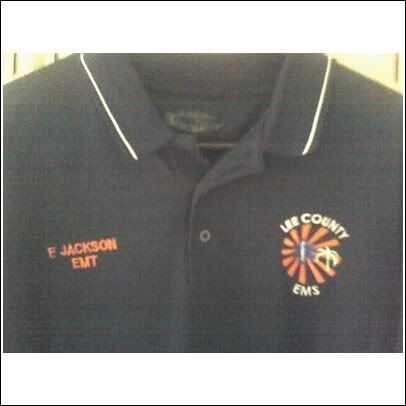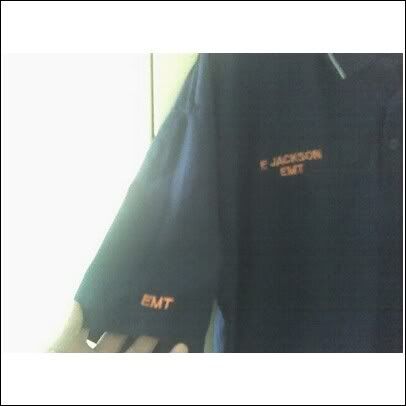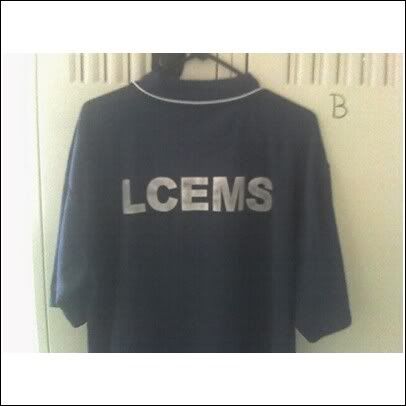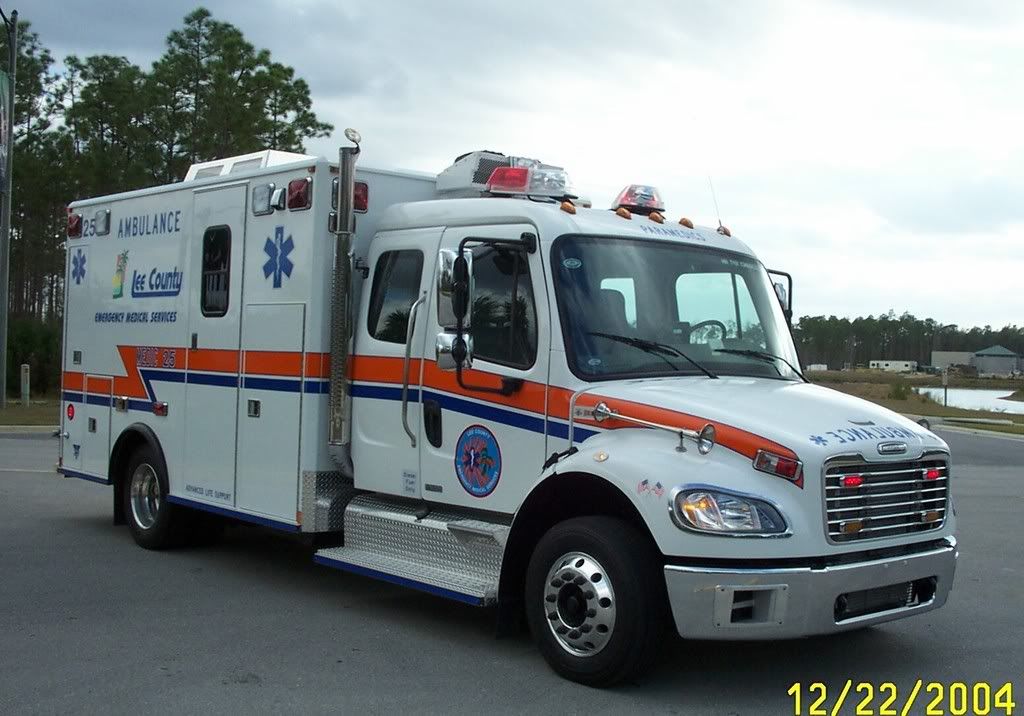-
Posts
338 -
Joined
-
Last visited
-
Days Won
1
Content Type
Profiles
Articles
Forums
Gallery
Downloads
Store
Posts posted by Niftymedi911
-
-
Hey guys,
Just wanted to let you all know I graduated paramedic school last week and I'm now awaitng my test date for the state boards for my license.
I now have my AS in EMS.
-
No hospitals are allowed to divert EMS unless deemed by our Shift Commander.
We must contact our shift commander on a Tac channel to requesting hosiptal destination. The patient's request, location, nature of illness, and priority are taken in to consideration. The trucks are rotated from hospital to hospital and when a certain hospital has an offload greategr then 1 hour trucks are sent somwhere else unless nature of call or priority precipitates that.
The only way the hospital cna divert is if they're on "internal disaster mode".
-
Mr. Dust,
I love it when we can chat and all get along.......
First,
The county is not looking at phasing basics out.... it's cheaper labor, and they are giving EMT-B's an expanded scope of practice(beta agonsit updrafts, nitro spray SL, ASA admin, IV starts under medic supvision) to make up for the lack of medics around. I can guarrantee if there were enough medics to put 2 on a truck and run the show... the EMT's would end up on the trasnfer division trucks. Which don't get me wrong is where I personally believe they should be. We do already have 2 BLS transfer trucks with 3 ALS transfer trucks, but I would like to see the system divided with EMT's running transfers and medics running the trucks as it should be. Perfect world situation..... but this isn't a perfect world.
The delima behind the Colorado vs 5.11. It all boiled down to cost. The county went with Coloroado's vs 5.11 is # 1 they were cheaper.... # 2 They were available through our uniform vendor.... # 3 It was the union who implemented the polo shirts into effect with our new contract and stated that they wanted this. The county wanted us to have Those Columbia fishing shirts.
# 3
I truly believe they are Dust. They allow the skin underneath the shirt to breathe and it aids the sweat in evaporating, thus cooling the body. Yes, we do sweat with the new shirts... but the material is light, the material breathes, the material drys extremely quickly, the material is wrinkle free. No matter how much you crumble the shirt up they stay wrinkle free and pressed.
The only draw back to the shirts is that with the new material... the weeves occaisionally unwind, thus producing, threads coming undone like velcro does to shirts. But they're easily sloved with a match.
To be honest, if the radio is on my belt and I don't have a speaker mic, I don't listen to it. If it's near my ear or face... I'm more often inclined to listen then not. We get status checks and they freak out when we don't answer. As stated... "they don't look professionally suited in the medical field". In all seriousness, if it's my life on the line..... they are professional... if it means the difference between hearing a scene safety update on the radio and not..... I choose the mic to hear it.. My opinion.
We've also gotten a lot fo feedback from the public saying with the new uniforms, it's easier to differentiate between crews and they look more professional. The reason why I say this is because medics here (not everyone but a few who always ruin it for everyone else) would almost never iron their uniforms or keep them pressed. Thus casuing them to be all wirnkled and very very unprofessional and sloopy. The new shirts stay pressed and winrkle free.. thus elminating that element.
Fire departments around here usually wear either gray or white T-shirts with their lettering. There are a few that wear class A's but its rare. But lately there been a big push to get either matching color polos with their logo on it or mathcing navy blue T-shirts. Damn copy cats.....
Without further ado.....




-
Basic crewmembers, and they have the "skills" to back it up? You're joking, right? Show me a dual medic crew, and you may have the beginnings of an argument.
And exactly where were you "hiding" last weekend, young Jedi? :wink:
I got cold feet and ran for my life........... No I closed on my new home on Friday and Saturday I had to work........ I had everything covered until my bank decided to roll a crazy 8 on me and close on Friday. But it's done!!! Finally...... Can we say PARTY???
Basic??? Dust you must be somkin something good..... Can I get in on some of that???? Medic/Basic, with soon transition to dual medic 12 hr for busy trucks.
I'm 4 classes away from completeing my AS degree.... I get my medic cert and graduate with my AS on April 28
 .. Finally, there is light to the end of the tunnel.
.. Finally, there is light to the end of the tunnel.Getting back to the OP.
We've actually gotten away from those class A's unless we're in court or PR event. The rest of the time, we've transitioned to Colorado's Cool Max Polo shirt's navy blue, with sewn custom patch, name, and rank on the front.... And a 3M reflective LCEMS emblem on the back. Very, very comfortable, professional, and functional. I'm extremly glad we've changed. The public definately can tell the difference between us now. And not to metnion I don't have to change three shirts a shift becuase I sweat so much. The new shirts allow us to breathe. We also wear the EMS navy blue pants by Elbeco with permantent creases. The only thing I would change would be to have either a small frabic strap sewn in either the chest or shoulder region for our speaker mics. Right now it usually hangs over my left shoulder or attached to my polo's fabric button flap.
-
In all seriousness......
Should you chose to discriminate and state that anyone who takes an anti-depressant to help them cope with stress of the job, shouldn't be doing EMS, toting that the drugs (in general) allow for an increased crew memebers and patient safety risk... The overall percentage for the risk is just as small was working with an obse partner and they code (due to massive MI) on you while their driving the rig. Extremly small percentage. If its going to help them stay at the top of their game and deal with the stress..... give it to them. But if the drug ultimately alters their decision making process, (such as certain drugs perscribed) they should be monitored closely with medical direction and document monthly evaluations
-

At least we've got the skills to back em up
 No hiding here.
No hiding here. -
yea but Dust, simply put if the person was blue, and the vent line was witnessed as kincked causing her to be cyanotic and arrest and he didn't catch up on it.......... that is neglience.
-
I was waiting for this thread to make it here. I almost got banned because the thread tunred into one of those volley vs paid / professional vs. pohdunk
They guy works part-time for a paid service and does volley on the weekends. Needless to say I stirred things up a bit lke DUst would and man did I ever get a response back..... check it out. I got a message from their Admin stating that if I posted one more thing to piss someone off he would ban me.
The site is worthless.... a bunch of volleys are the attendees.
-
-
lol
-
Niftymedi911, you are an excellent spokesperson for Lee County EMS.
But, don't forget to mention our cost of living factors for housing, insurance, utility rates and taxes. And then for the family oriented types, there is the little matter of our schools being poorly rated and over crowded. Private education is expensive and can be poorly regulated. Jeb's voucher program kinda crimped the whole system.
I thought about taking Ashley's place as PIO when she left. But I'm not ready to sit behind a desk yet. Maybe in 10 years I'll try.... If they decide to ditch the new one we have now. Who knows, after my Master's degree, I could be chief 25 years from now...
 (That's my ultimate goal)
(That's my ultimate goal)Also, LCEMS hasn't given me any REAL problems (of course there are little ones and complete BS that anyone would moan and complain about). the three years I've been here, I'm happy, I guess that's why it is so easy for me.
Yea, allow me to devolve some more: Taxes SUCK (well this year I only have to pay 2,100 bucks which anit bad), The home/auto INSURANCE SUCKS, Gas Prices SUCK, and Traffic SUCKS. Watch out for FPL (Florida Power Light) they will rape you like nobody else's business. Schools are ok ( I'm a by-product of them) not the best, but certainly not the worst. The only thing I TOTALLY DISLIKE is the school choice horse-crap. If you have recently moved your placed in like a lottery system. If your close to the bottom your child could end up going to a school on the other side of the county.
Brent,
Yes, our agency still requires you to do the physical. Oh BTW, they are hiring EMD certified dispatchers and call takers for Lee Control (our dispatch center). They ultilize: Pro Q/A, EMD, Priemere MDC by Motorola, PrinTrak CAD system, ATM with agency layering GIS Mapping, and SIREN technology (New breakout as of March 1st, 2008) They start @ 13.83/hr (Communications Trainee) plus bene's for 12 hour shifts. Once you pass your training (approx 1 year in length) your then passed to Communications Operator I, your hr rate is them bumped over 17/hr.
[web:2049b0edaf]http://en.wikipedia.org/wiki/Lee_County%2C_FL[/web:2049b0edaf]
-
American LaFrance or Horton are my two favorites. But with ALF filing for chap. 11 bankruptcy... I dont know anymore.
Also, would we used plain language or Signals and 10-codes for dispatch?
-
If you want a change in scenery......
Try Lee County EMS in Lee County, Fla.
3rd Service ALS primary 9-1-1 response and Inter-facility Transfer Division.
We currently have 13 EMT positions and 23 Medic positions open.
EMT's starting $13.38/hr or $44,860/yr
EMT Max @ 19.76/hr or $62,300/yr.
Medics starting at $14.76/hr or $52,000/yr
Medics Max @ 23.00/hr or 73,000/yr
100% Paid medical/dental/vision, short/long term disability/FRS.
Paid EMT to Paramedic promotion program. The county pays you while you attend school, pays for your schooling and pays for all the costs you incur for certifying. I"m currently in the program and I finish next month and haven't had to drop a dime for school.
24 Hour / 12 Hour shifts
Check it out: www.lee-ems.com/ems/default.htm
-
Call Trauma Alert
Immediate C-spine, occlusive dressing with pressure (Ace wrap), oxygen via BVM insert OPA, backboard, rapidly place in truck. Grab a FF, jump in the truck.
Once in truck and enroute to hospital, intubate, 2 large bore IV's, secondary assessment, call report and pray he makes it.
-
Response:
ALS First Response (I reccomend putting our ALS medics on FD trucks, thus completely elminating the need for FF"s to be medically certified or at the very least basic) // ALS Transport
Levels:
9-1-1 // IFT // AeroMedical // Critical Care
24 hour fixed stations for the more rural areas with also 12 hour fixed stations for the more urban areas.
Closest Unit Response
EPCR:
Image Trend EMS Bridge ver 2008
Dispatch:
Combined one dispatching system and center for all of FD/EMS/PD/SO.
Preimere MDC by Motorola with ATM/GIS mapping and SIREN technology. Re-banded 800 mhz Smart-zone radio system and Sprint Air cards.
CAD/ MDC / MPDS (better triaging of priority calls and thus hopefully elminating the Lights and Sirens response to BLS calls.)
Ability for Medics to fill in voids in dispatch during low staffing or high demand incidents. (Overtime!!!!!)
Medical Direction:
One set of guidelines for the entire county/city.
"Guidelines"........ I would also like to see PA's in the field with QRV's. Thus being able to provide total medical care. Due to the fact of EMS being the primary line of healthcare for most of the population, if we can incorporate 2 or 3 PA's that work under the medical director, but can respond to your scene if you need assistance. Or even better, instead of "you call, we haul" syndrome. Let's say you respond to a personal injury to an 76 y/o/w/m. After careful assessment, the only thing you can find is a 3" lac that needs suturing. Instead of transporting him to clogg the hospital system even further. You can radio for the patient be seen by a PA, have the wound sutured, prescribe pain meds if necessary and can appoint a follow-up MD for further evaluation. Thus hoepfully only transporting patient's who really need to go to the hospital. (Ii will never always happen but at least its a shot in the dark).
Administration:
Director of Operations
Director of Training
Director of Quality Assurance
Director of Special Incident Response
Director of Information Systems/Technology
All would form a region council of directors, instead of one blabbing chief. Field Supervisiors would eventually be responsible for their persective sector or zone. Captains would be responsible for scheduling and day to day operations of the fleet. A Transport Advisor, for hospital designation for units on a seperate tac channel. They help control the flow of the fleet to different hospitals to aviod extreme offload times. Thus allowing EMS to control the ER's from "diverting" units due to being busy.
Completely integrated EMS billing department and system that also can interface with the hospital systems allowing to get 100% of all insurance info and personal info. Hopefully gaining that necessary boost in collection rates.
Education and Training:
20,000 sq indoor/outdoor regional training facility. County(or city)wide for all responders to train and educate under one set of guidelines, equal equpiment, and get to know personel better. The buidling will house seperate quarters for all of the training department staff. Will also house an accredited ASS degree program for EMT through Medic conditioning. The training center will also house a state-of-the-art scenario room. Will have numerous divided rooms and also ambulance boxes will manikins and equipment for every year conditioning. Every year, the training department will apply a re-conditioning course for all road crew to keep up their skills and necessary assessment skills. Also, with house EVOC, HazMat, and Critical Care programs. Allow FTO's to ride as third crew member on sporadic or spontaneous units to better view the overall performance of personnel, to see wether or not certain items need to be inserviced individually and agency wide. Monthly in-services with Cardiologists, Trauma Surgeons, Neurologists, Pediatrics, and most importantly OUR Medical Director.
Uniforms:
Poly-Pro high performance Polo shirts with custom lettering.
Logistical:
100,000 sq ft. Warehouse // Maintainence Facility
Uniforms, Backboards, KED's, Furniture, Support supplies, Office supplies, EVERYTHING!!!!
Numerous supply depots positioned throughout the county/city. Online ordering of supplies and afternoon delivery to your assigned depot.
Every 45 days the trucks are taken out of service, detailed, deconed, fixed, oil change, tire rotation, computer diagnostic, Washed/waxed/buffed.
-
Our county has a population of 850,000 full time residents and during the seasonal months (Jn-April) we have nearly 3 million residents. We have 28 24 hour trucks that are stretgically placed within the county at the various FD stations. We do have a stand-by policy (Post as some refer to them) in place. Each truck has a zone (8:59 response time limit) that they respond in. If Medic 4 and Medic 14 that for instance cover zone 4 and 14 are out, Medic 20 (zone 1, there are 4 trucks in zone 1, 3 trucks can be pulled from zone 1 leaving 1 truck to keep zone 1 at 8:59 response) is placed at station 4 to keep the 8:59 response time goal. We also have 3 12 hr 911 response trucks for peak times within the heart that also have stations (but no assigned zone). They commonly used as needed to cover zones. We also have a 6 truck interfacility transfer divison that solely does transfers. The ultimate goal was to take the load off the 9-1-1 trucks and earn that extra income. In Lee county, there were over 9500 interfacility transfers between the 5 county hospitals.
After every call unless needed for coverage, we return to our assigned station and wait for the next call. Well not wait, but recline... you get the picture. We cover over 1100 sq miles of our county with those 31 trucks. We also have 2 helicopters and 1 Critical Care transfer truck. (MedStar operations)
We answered 74,452 9-1-1 calls, 9,500 interfacility transfers, and transported 1100 patients by helicopter.
-
:hello1: Thanks Dust for putting my big post into 3 sentences.
-
Both. I hate trying to put senarios in words because sometime I leave things out. sorry
-
For a tiered BLS/ALS service or strictly BLS I could see a glucometer being used. In situations where let's play the devil's advocate and think........
You respond Hot BLS to a diabetic (26B1 I think) or whatever code you use. UPA, you see a 68 y/o/w/m seated in dining room chair. Patient looks at you when you enter but cannot talk. Patient is pale, clammy, slightly moist skin, breathing somewhat increased. You send your partner to find info and meds. You do a quick bp: 182/90. He brings back a medication list which includes Insulin, Digioxin, and Norvasc. You see a glucometer out of the corner of your eye. You do a quick neuro exam and notice facial droop, inability to talk but is able to open mouth, but is aware to surroudings. It's 2134 hrs in the evening. So you prepare oral glucose and call for ALS back-up. Dispatch advises you that the nearest ALS truck is 10 minutes away. Your 4 minutes L/S from the nearest ER. You administer oral glucose and wait for 3 or 4 minutes for it to take effect. You reassess the vitals and neuro exam. Facial droop still present, inability to talk still present, and now isn't very aware to what's going on. You and your partner quickly grab the patient and place him on the stretcher and "load and go". UPA hospital, blood glucose levels were in the mid 200's. The MD orders CT of the head and reveals an hemoragic stroke.
Not only did you give glucose to a known insulin dependant diabetic that was not warranted, but now you administered glucose to a stroke patient. A simple glucometer reading could of been accomplished to determine that this is a stroke patient versus a diabetic patient. Those extra 6-10 minutes you spent on scene administering the glucose and waiting for it to take effect, are brain cells that patient was losing due to your limited capabilities and assessment skills.
I do not believe in BLS/ALS tiered response. I believe Full ALS response is the only true definitive care for any patient (Besides a fall or Lac).
EDUCATION #1
ASSESSMENT SKILLS#2
-
LOL to above, I love that show.
-
Adenosine, Cardizem... would be my guess meds that prolong the action potential. And WPW morphologies within the conduction system. Specifically the alternate conduction pathways.
Antiarrythmics techincally are called per ACLS post V-Fib arrest. But no matter how much, or what is given, nothing can help besides bright lights and cold steel.
-
It's agency specific, one of our Paramedic FTO's created the idea and system for LCEMS.
Here's a link for a pic of the bins:
http://www.acehardware.com/product/index.j...oductId=1288986
-
They're simple kinda like what you describe.
We also have 2 Jump bags. Blue bag: Medications / IV start supplies / BLS. Green Bag: Airway / Oxygen. These are not speedload.
We re-stock the bags from the bins. We use the supplies out of the bags first.
All of the bins are numbered and orgainzed according to BLS or ALS. ALS Airway 1 CPAP, Airway 2 Adult Intubations, Airway 3 LMA's, Airway 4 ETCO2 adaptors and CareVent Circuits,) ALS 2 IV supplies, ALS 3 Zoll Monitor supplies, ALS 4 Needles, ALS 5 Cardiac Med's, ALS 6 CAM (Crash Airway)Med's, ALS 7 Nitro/Dopamine , ALS 8 Diabetic/Respiratory/GI Medications, and ALS 9 1 Complete cardiac Arrest bin ( Has everything to work 1 code with). IV 1 is specialized IV fluids ( D5W 100cc's, etc) IV 2 is IV pump supplies. BLS 1 is Adult BVM's, BLS 2 is Pedi BVM's, BLS 3 is suction supplies and BLS airway (NPA, OPA), BLS 4 is Infant BVM's, BLS 5 Trauma dressings, BLS 6 and BLS 8 are Bandaging and other various supplies. BLS 9 are Zoll Disposable B/P cuff's. OB/ GYN are not sealed in bins. BLS 10 is H2O and Peroxide.
They're restocked in plastic bins like this:
http://www.acehardware.com/product/index.j...oductId=1288986
Open with no lids but plenty of room for storage. Plastic bags are then placed around covering the entire bin and then heat sealed on one side. We just rip the plastic to gain access to the bins.
The overall idea for the Speeload was 3 fold. One 90% accountability or higher with the supply accountability. Quicker truck check outs in the morning and less confusion. Everything organized.
Every morning we do our truck check outs the bins are stocked with the necessary items per state FL DOT reccomendations and some agency specific items and par levels. It can take 15 minutes to check everything out vs just under an hour to do the check list the right way. At first I didn't like the idea. But now I really like the hassel free re-stock. I never have to count because I just swap bins out when they're open.
We're in the process of obtaining 1 of those Medication vending machines for trial to place in the depots for the medications not carried in our bins (Morphine, Fentanyl, Valium, Versed, Ativan, Succ's, Ditilizem). Right now our DO's drive around the county to re-stock. But they're gonna change that too.
-
Young 50 y/o male of Asian decent. The history of bad nightmares would provide better understanding of undiagnosed Burgada's syndrome. It just confirms the diagnosis. I would scehdule a cardiology consult and schedule for ICD placement.



Unresponsive 17 y/o male
in Education and Training
Posted
My thoughts:
Hyperglycemic Hyperosmolar Nonketotic Syndrome (HHNS) with New onset DM Type II
Type 2 diabetics often retain enough pancreas function to avoid ketones. In this case, blood acidity does not occur, hence the absent kussmaul breathing. Whereas highs in Type 1 diabetics lead to ketones and blood acidity that causes DKA, Type 2 diabetics tend to get highs without ketones leading to HHNS. HHNS is a form of high blood sugars that occurs with Type 2 diabetes, whereas ketosis is more common with Type 1 diabetes. It is quite different from the "ketosis" or "ketoacidosis" that occurs from ketones in highs, but almost as dangerous. HHNS occurs more commonly in Type 2 diabetics who retain enough pancreas function to avoid ketones, but who can still go dangerously high. Being high for prolonged periods causes severe dehydration from frequent urination.
Because of the frequent urination and overactive kidney function, the mensenteric arteries and vessels are still profusing thus resulting in a normotensive blood pressure. The decreased repiratory effort is caused by the extremly high blood sugar count and causing the brain to shut down. Which is also causing the lack of a gag reflex. The elevated pulse is a compensentory mechanism for the apena.
Hope this helps.